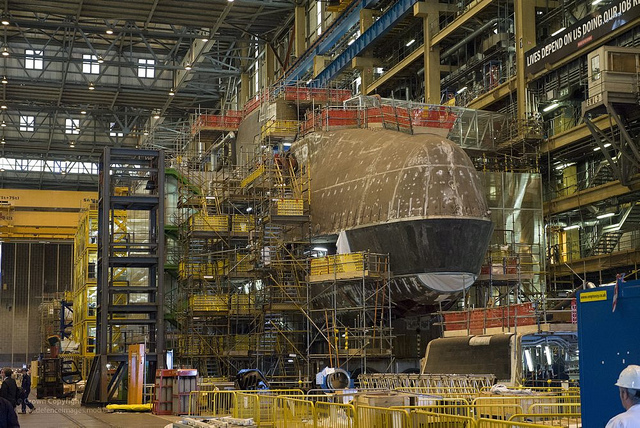
Having identified the key concepts behind estimating the
economic impact of defence industry and the capital equipment projects that support it, I want to illustrate how those concepts play out in practice, with a focus on job creation.
To illustrate the issues, I’ll use a purely hypothetical example—the economic impact of building six Collins-class submarines in Australia, commencing in 2013–14, following the same approach to production used for the original vessels and paid for by higher taxes. Most of the
economic data relating to this scenario is in the public arena, albeit in an
early form. From this and other information (
here,
here and
here), the following picture emerges.
Using input-output (I-O) economic modelling—which estimates only the benefits in a particular sector of the economy—an Australian submarine build costed at approximately $15 billion should support around 3,000 full-time equivalent jobs nationally over a 16-year build period. This consists of around 1,100 jobs with the project’s prime contractor, plus another 1,900 jobs generated in companies further along the project supply chain and by the consumer spending associated with all those employed within the production chain. To put this into perspective, 3,000 jobs represents less than 0.03% (three hundredths of 1%) of the total Australian workforce.
However, these figures relate to economic benefit only. They don’t cover the project’s economic costs. When these costs are considered by switching to computable general equilibrium (CGE) economic modelling—which also estimates the opportunity costs in other parts of the economy—the average number of jobs created in net terms across the economy is around 700—provided the submarine builder is internationally price competitive.
Approximately 3,000 jobs are still associated with the build (the economic benefit). But approximately 2,300 jobs are lost elsewhere in the economy (the economic cost). The figure of 700 net jobs, as well as the figures below, incorporate the employment effects of the tax revenue that government gains (and loses) from Australian industry participation in submarine construction.
Compared to an overseas build, building the submarines in Australia at an internationally competitive price creates around 600 jobs in net terms across the economy or 0.005% (five thousandths of 1%) of the total Australian workforce. This figure is slightly lower than the 700 net jobs mentioned above because, even for an overseas build, Australian industry will provide some input.
If an Australian build costs 20% more than an overseas build, the comparative figure of 600 net jobs drops to 500 net jobs. We should note that the price premium associated with the original Collins build is difficult to identify.
Three main factors drive the results when economic benefits and economic costs are both considered. First, at least a third of the project’s total cost is made up of components, materials and services supplied from overseas. Second, the build doesn’t add a lot more value to the economy than the activities that suffer from the vessels needing to be paid for—in this case through a (non-distortionary) tax. And third, the workforce needed to build the submarines consists predominantly of people already employed elsewhere, or with reasonably strong prospects for alternative employment in the longer term.
Although quantifying the last of these factors can be complex, the rationale behind it is straightforward. Most people who build submarines appear to share few, if any, of the
characteristics of the long-term unemployed. If you can build something as sophisticated as a submarine—or can be trained to do so—chances are you might already have job or can find one if the need arises.
The picture is brighter for South Australia, where approximately 1,800 jobs are generated. This equates to around 20% of the number of jobs the state is estimated to lose initially from the closure of motor-vehicle production nationwide. It accounts for around 0.25% (a quarter of 1%) of the state’s total workforce.
Why does South Australia gain so much relative to the nation as whole? It’s simple really. The state attracts most of the economic benefits of the build in the form of industrial workload, while most of the economic costs (described in part 1) are borne by taxpayers and industries in other parts of the country. Victoria and New South Wales are particularly disadvantaged.
So, what can be deduced from all this? Well, if submarines are anything to go by, the following conclusions emerge.
In the quest to determine the nationwide employment effects of projects, economic benefits and costs should both be considered. After all, what some individual stakeholders gain in new jobs from the projects will come at the expense of others, if only because the projects need to be paid for somehow.
Even if paying a price premium to secure projects for Australian industry is justified, the national employment outcomes of projects could be significantly lower than first impressions suggest. This implies that the value to Australia of these projects rests more with national security than with job creation. However, this comes with a caveat—it remains important to measure and understand the real, net, effect on jobs.
 Print This Post
Print This Post